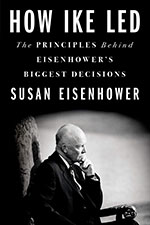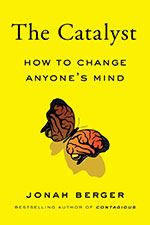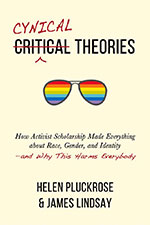 VERDICT: Touchdown!
VERDICT: Touchdown!
How Ike Led: The Principles Behind Eisenhower’s Biggest Decisions
By Susan Eisenhower (New York, NY: Thomas Dunne Books, 2020). 365+ pgs. $21.61. Order, www.amazon.com.
Reviewed by James Casey
The author of this engrossing book – Susan Eisenhower – is a granddaughter of Dwight D. Eisenhower, the 34th president of the United States (1953-61). Dwight Eisenhower had a distinguished military career (most famously as the architect of the D-Day invasion and NATO commander) and academic career (president of Columbia University) before assuming the presidency.
The author shows what leadership is through case studies. This is the ultimate strength of the book. Topics covered include U.S. Supreme Court appointments, accountability, ethnic kinship, personal political leanings (and the lack thereof), shaping the middle way, rules for good governance, the relationship between war and peace, Wisconsin Sen. Joseph McCarthy, foreign policy and relations, civil rights, and Eisenhower’s post-presidential years (1961-69). These chapters illustrate the depth of issues that were facing the United States during the Eisenhower years. The 1950s are generally portrayed as a boring and sleepy era, but this book helps make clear that era was anything but boring and sleepy.
The discussion of the U.S. Supreme Court might be of special interest to lawyers. Eisenhower appointed Chief Justice Earl Warren (1953) and four Associate Justices: William Brennan (1957), Potter Stewart (1959), John Marshall Harlan II (1955), and Charles Evans Whittaker (1957). Of particular importance were the appointments of Chief Justice Warren and Justice Brennan. Eisenhower thought that the Supreme Court should have a balance of Republicans and Democrats because he believed that would best preserve an impartial, apolitical nature on the Court. Warren was a moderate Republican (or so Eisenhower thought), and Brennan was a Democrat and Catholic. These appointments represented Eisenhower’s “middle way” approach to governing. Beginning with Brown v. Board of Education and continuing through the 1960s, the Warren Court expanded the civil rights of Americans.
This book is a must read. It is well worth your time and attention.
James Casey, Dayton 1988, is an attorney, privacy advisor, and CUNY Adjunct Associate Professor in Washington, D.C. He is a State Bar of Wisconsin delegate to the ABA House of Delegates; a member of the State Bar Board of Governors, the Nonresident Lawyers Division (NRLD) board, and the Lawyer Well-Being Task Force; and a past president of the NRLD.
 VERDICT: It’s a Keeper!
VERDICT: It’s a Keeper!
The Catalyst: How to Change Anyone’s Mind
By Jonah Berger (New York, NY: Simon & Schuster, 2020). 270 pgs. $18.61. Order, www.amazon.com.
Reviewed by Thomas J. McClure
In chemistry, the word “catalyst” refers to things that enable other things to change, often in a more productive, multiplicative, or synergistic way. In this well-written and crisply paced book, author Jonah Berger uses the metaphor of a catalyst to describe five persuasion strategies that can determine whether people will respond to an opportunity to change. The book encapsulates both some history of marketing campaigns and a survey of current techniques that are interesting and thought provoking.
Berger is a prolific business consultant and writer in addition to his day job as a marketing professor at the Wharton School at the University of Pennsylvania. Rather than focusing on the theoretical, Berger’s analysis relies significantly on case studies that dramatically illustrate the ways in which people make decisions in real life to resist, or embrace, change. Reading this book is not an academic endeavor but more like a quick travelogue through the quirks and logic of the human condition, where remarkable things in sales and corporate worker improvement can be accomplished merely by applying new ideas to old problems. The book is for “anyone who wants to catalyze change,” and it contains convincing evidence that Berger has a good grasp on the best ways to do so.
The book is basically structured into five chapters, each covering a “catalyst” technique that the reader will find mind opening yet somewhat familiar. With Berger’s guidance, readers can readily see how each technique can help move people to reconsider their default positions, or choices, on everything from internet purchasing, to getting behind corporate initiatives, to changing voting decisions. The chapters represent each of Berger’s five key concepts: reactance, endowment, distance, uncertainty, and corroborating evidence.
Reactance, or the natural resistance to change, can be overcome by persuading people to convince themselves by talking through the issues. Endowment, or reliance on the safety of the status quo, can be overcome by illustrating the cost of falling behind if one does not act. Distance, in the form of antipathy to a proposal, can be lessened by small steps of finding a mutual acceptance point, then expanding the discussion to overcome a person’s boundary of rejection.
Uncertainty, or fear of failure, is overcome by offering simple options to try new things so there is no downside to the consumer, for example, by offering free test drives, free samples, free shipping, and lenient return policies. Finally, corroborating evidence refers to the behavioral science of using multiple resources, and their timing, to progressively build confidence that a change is in a person’s interest. Each chapter ends with a real-life case study.
Lawyers engaged in acquisitions, sales, negotiations, advocacy, plea bargaining, mediations, or trial work, to name a few, will find substantial food for thought to hone their persuasion skills with this contemporary marketing primer.
Thomas J. McClure, Marquette 1980, operates Thomas J. McClure LLC, Delafield.
 VERDICT: It’s a Keeper
VERDICT: It’s a Keeper
Cynical Theories: How Activist Scholarship Made Everything about Race, Gender and Identity
By Helen Pluckrose & James Lindsay (Pitchstone Publishing, 2020). 351 pages. $19.61. Order, www.amazon.com.
Reviewed by Kevin M. Connelly
According to the authors, “white fragility,” “implicit bias,” “cultural appropriation,” “intersectionality,” “privilege,” “silence is violence,” and many other similar terms are the lexicon of a tribalistic and cynical ideology that underpins the current social justice movement.
Examining decades of social justice scholarship, they trace the underlying theory from its origins in the diffuse radical skepticism of postmodernism philosophy of the 1960s through its evolution into present-day group identity variants including critical race theory, postcolonial theory, queer theory, intersectional feminism, and gender, disability, and fat studies.
Two core principles frame these theories: first, a radical skepticism of universal objective and scientific truth because, it contends, all knowledge is relative as a cultural construct of power. Second, society is formed by systems of power and hierarchy wherein a dominant culture, such as white western culture, oppresses marginalized cultures using language and “discourses” to maintain its privilege.
This conceptual framework led to the worldview that power imbalances and prejudice exist everywhere, in all social relations, all the time, though largely invisible. For example, the history of civil rights progress in this country may appear to have been a moral arc, but, according to the late legal scholar Derrick Bell, a leading progenitor of critical race theory, achievements such as desegregation were just measures “whites allowed” in furtherance of their self-interest.
Casting aside the epistemological rigors of the western scientific method, members of marginalized identity groups have constructed their own knowledge, (rewritten) histories, and truths derived from “lived experiences” and “standpoint theory.” Dissent is not tolerated; to question these theories and their relativistic truths is to commit “epistemic oppression.”
With dogmatic and nonfalsifiable precepts (like a religion), these theories escaped the academy to fuel the identity-based activism we see today. For example, antiracist activism jettisoned the colorblind and individual rights political goals of liberalism as deficient and naïve in favor of race-identity tactics targeting “white privilege” and “systemic oppression.”
Theory-educated activists have ensconced themselves in “diversity, equity and inclusion” offices and “bias response teams” in universities, corporations, and governments to enforce the truth according to social justice.
The obvious casualty is free speech: Saying the perceived wrong thing has often led to public shaming by “cancel culture” or losing one’s job (James Damore fired by Google); scholars who publish papers straying from the orthodoxy have had death threats and coerced retractions (Bruce Gilley); STEM departments and school curricula are pressured to incorporate critical race theory; speakers are removed from programs; physicians worry their advice might be construed as fat shaming.
The authors note the contradiction that critical race theory begins with the belief that all categories, such as race, are socially constructed, and then does exactly that in its activism – it puts social significance back into racial categories, which inflames racism.
All lawyers who believe Enlightenment values have been, and will continue to be, the best path for social progress must read this book to be equipped to recognize and resist this well-intentioned but counterproductive ideology.
Kevin M. Connelly, Duke 1988, operates Connelly Legal Services, Westby.
Want to Review a Book?
Please request a book and writing guidelines from Wisconsin Lawyer managing editor Karlé Lester, at klester@wisbar.org or (608) 250-6127. Reviewers may keep the book reviewed. Reviews of about 500 words are due within 45 days of receiving the book. Reviews are published, space permitting, in the order received and may be edited for length and clarity.
Cite to 94. Wis. Law. 37-38 (January 2021).
